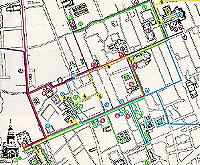ARTISTIC ITINERARIES

The rapidly changing tastes and the often chaotic pace of our lives has created a barrier between the tourist and the work of art from the far distant past. The information media, however, can be utilized by the cultural establishment to bridge this gap and present the visitor all the possible information for understanding and penetrating these works of art.
A STRATIFIED, MULTIPLE ITINERARY MAP of the Old City of Naples is one way of bridging this gap, and the aim is to facilitate your visit of the city by providing four intineraries, each one corresponding to a style:
The TOURISTIC ITINERARY includes the most important monuments mentioned in the other four itineraries.
An other very interesting itinerary is the way from piazza PLEBISCITO to piazza S.DOMENICO MAGGIORE.
From an examination of the works of art, there emerges an image of 2,500 years of stratification whose various elements live side by side in perfect harmony. From this standpoint, Naples is the only major European city which can show the tourist a stratification through time without the interference of dissonant elements, almost as if it had been planned that way from the beginning.
Remains of Greek and Roman Naples (6th cent. B.C. - 4th cent. A.D.) can be found in the present-day Piazza S.Gaetano dating from the 17th century, in the Baroque church of S.Paolo Maggiore with its Corinthian columns and "opus reticulatum" wall of the temple of the Dioscuri, and the Basement of the nearby church of S.Lorenzo Maggiore dating from the 14th century where the pavement of the Paleochristian basilica has been uncovered and below that level are to be found the remains of the Roman curia, the street and the Greek shops, all of wich are visible. This was the forum or center of city life out of wich led the three “decumani” corresponding to three streets of the present-day city. These are the “Decumanus major”, today called via Tribunali and crossing Piazza S.Gaetano, the “Decumanus superior” which goes from via Sapienza to Piazzetta SS.Apostoli and the “Decumanus inferior” going from the present Piazza S.Domenico Maggiore to the Mura Greca at the end of via Forcella. These principal roads were linked by the cardines (the present-day vicoli or alleyways) whose crossing formed the insulae or block of houses isolated or groupped together by high walls. It is within this framework that Byzantine, Medieval, Renaissance and Baroque Naples, grew, and remains essentially unchanged at present, taking into account the elimination of many of the cardines and all of the ornamental and vegetable gardens that once brightned the old houses.
Stratification, reflecting more then, has respected at time even the old habits: where the forum with its shops once stood now stand the populos market atalls under the Medieval arches displaying spectacular arrangements of fruits and vegetables, fish and other wares--all very Baroque in appearence.
Further on stands the church of the Purgatorio ad Arco dedicated to the cult of the dead, coming down to us more from the Greek conception of Hades than from Catholicism. Walking up via S.Gregorio Armeno, we come upon the base of a wall with a frieze, nearly rubbed out, of Ceres, the Goddess of Fertility. A bit of the wall from her temple remains in the nearby church of S.Gregorio Armeno, consacrated to S.Patrizia the virgin martyr that young brides ask to frace them with many children.
Stratification continued throughouth the centuries. Laymen and religious orders, influenced by changing fashions, felt the need to make changes and additions to the works of art in their possession. Thus, with the coming of the Aragoneses, the structures of the Catalonian and Angevin churches were hidden beneath a covering of pictorial and marble decorations created by the artists of the 15th, 16th and 17th centuries.
This is why the same church or monument may appear on more than one itinerary.
COME BACK TO:

